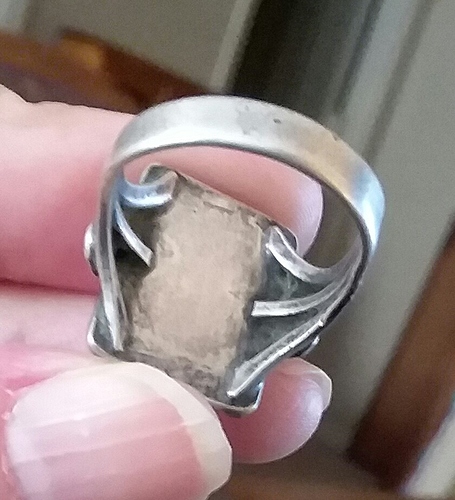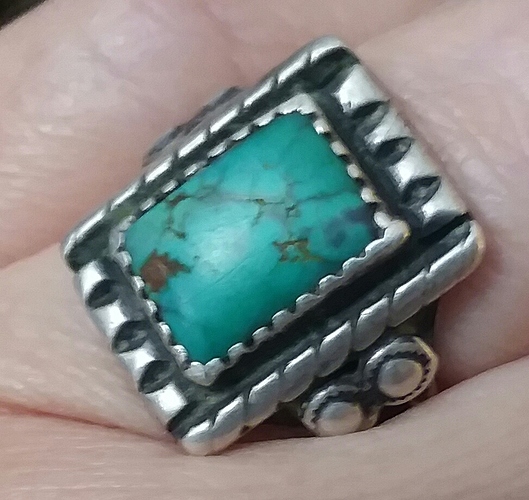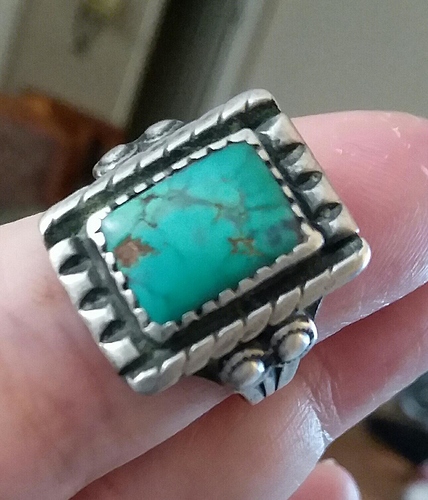A new pretty. Looking for opinions on age/origins. It feels amazing on the hand, worn smooth on all corners and edges.
It takes a very long time to smooth out the silver design like that. Turquoise will be difficult.
yup it sure does. i wasn’t holding my breath for a stone ID, just an age guess. 60s maybe? IDK. Navajo-ish?
If the sides were twist wire it would, but I don’t think they are, or if they were, the silversmith ground the outside edge on a flat lap , or wheel to get the flattened, angled edges. Almost looks like the backplate is one piece, cast from wax, or carved and stamped from a a solid heavy gauge billet silver sheet. The same kind of wear occurs from, or can be deliberately created by over-buffing. Beads on the sides are odd. Look handstamped but don’t look Navajo at all. Neither does the serrated bezel which is flat and even at the top and widely spaced as opposed to narrowly spaced bezel hand cut with a checkering file and filed sharp at the tips. That kind of pattern is created with each individual serration cut with a triangle file. Best guess is this is genuine old ‘Hippy’ silversmith jewelry out of Santa Fe or Taos. It’s handmade and quality vintage American Craft for sure, but I doubt it’s Indian made.
“Ish” sounds about right. You know, there’s a whole lot of jewelry out of New Mexico and Arizona made in this style by accomplished American craftsmen (non-indians) who fell in love with the genre decades ago, and between the mid 60’s and the early 2000’s produced some of the finest examples of southwestern Jewelry ever created. Those who are really serious about collecting and identifying artists need to look for names like Jennifer Sivohnen (Taos), Mona Van Riper (Santa Fe), Lionel McKinney (Gallup), Richard Stump (Santa Fe), Doug Magnus (Santa Fe), James Rogers (Gallup/Albuquerque), Patrick and Anita Ohlinger (Taos), Horst Schrader (Santa Fe), Giselle Hensel (Santa Fe) David Deer (Poquaque), Gary Gordon (Gallup) there are many, many more to discover. These were and are the non-Indian movers and shakers in traditional Southwestern Jewelry. Some of the finest pieces ever made, with some of the finest stones ever mined have been created by these incredible artists. Keep an eye out for their work. You won’t be disapponted!
my impression of the constructon from just wearing and looking at it all day is that the two side pieces are carinated that had been shallowly filed to look like rope. The north and south appear to be half round that was cold chiseled or filed. The back plate feels to me like thin sheet, the whole ring i bet isnt a 1/4 inch thick. I noticed i only showed one side of the shank, the raindrops almost looked like they were stamped with a small punch. I’m enjoying it regardless of origin, and appreciate your observations!!
It’s a quality ring. Really beautifully made. The turquoise is genuine, high quality and beautifully cut. You could be right about the side sections. When I first saw the image, I thought the same thing.
You’re either a silversmith yourself, or well familiar with the techniques involved. This is something a non-expert wouldn’t pick up.
I appreciate the generous comments. Im not a smith, but definitely a student of the art. I love things that show the maker’s hand, or have lived a well worn life, especially silver. I have a feeling this one may be almost as old as me, just from how worn smooth the whole face is. Even if its ‘in the style of’ rather than NA, i’ll enjoy it for years to come.
Cheers.
Thank you!! I’ll have to do some homework!
Went to an Exhibit of old Spanish art at the Albuquerque Museum last year. Within the exhibit were pieces made by Hispano-Roman craftsmen literally two thousand years ago… I was floored.The processes and techniques used at that time to make jewelry were literally identical to the processes and techniques used in traditional Southwestern and Native American Jewelry today. In my shop, At my bench. This is an old, old craft, practiced and passed down from the Greeks and Romans, to the Spaniards, and from the Spanish to Native Americans, and to the rest of us who love and work in this genre. Even after as many years as I’ve been doing this, the history and evolution of the craft is absolutely amazing and awe inspiring to me.
How amazing that the knowledge of the techniques has not only survived, but is still in continuous use. It is one of the things I admire about NA crafts is the dedication to the methods and keeping it going.


